 BUY IT AT AMAZON: CLICK HERE!
BUY IT AT AMAZON: CLICK HERE!
STUDIO: Warner
MSRP: $26.98
RATED: G
RUNNING TIME: 98 min.
SPECIAL FEATURES:
Disc A
• Deleted Scenes
• Lost Footage
• MGM Parade Excerpt
• The Thin Man Episode: Robot Client
• Sci-Fi Trailer Gallery
Disc B
• Bonus Feature Film: The Invisible Boy (1957, 89 min)
• Watch the Skies!: Science Fiction, the 1950s and Us
• Amazing!: Exploring the Far Reaches of Forbidden Planet
• Robby the Robot: Engineering a Sci-Fi Icon
The Pitch
“But how is it / That this lives in thy mind? What seest thou else / In the dark backward and abysm of time?”
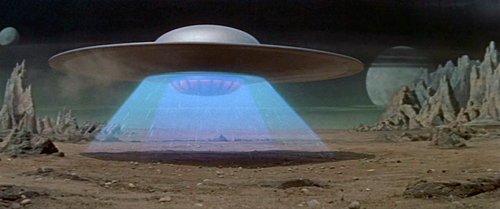
The Humans
Walter Pidgeon (Harry In Your Pocket), Anne Francis (Bad Day At Black Rock), Leslie Nielsen (Nuts), Warren Stevens (Gorilla At Large), Richard Anderson (The Six-Million-Dollar Man), Earl Holliman (The Sons of Katie Elder)
The Robot
Robby (Gremlins)
The Nutshell
I’ve watched Forbidden Planet
more times than I can count. Still, I know better than to assume that
everyone reading this article has seen it as well. No offense, but the
sad fact is that some people hear the words ‘old movies’ and squirm
away as if Mom was trying to comb their hair in front of everybody.
That’ll never change as long as new movies keep coming out, but whether
you know it or not this flick is a big part of the reason people like
us read websites like this. That said, Here There Be Spoilers.
In the 23rd Century, Commander J.J. Adams (Nielsen, waaay before The Naked Gun) and the men of United Planets Cruiser C-57-D travel to planet Altair-4 in search of the Belerophon, a vanished exploratory spaceship. They contact a single survivor, Dr. Morbius (Pidgeon), a linguistics expert; and are met upon touchdown by his remarkable ‘robot manservant’ Robby.
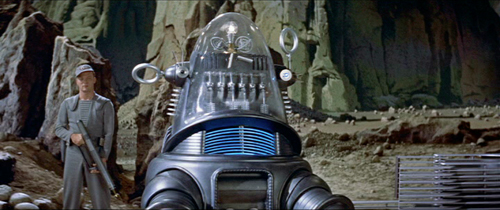
"-I-don’t–usually-work–blue.-"
Morbius isn’t exactly a gracious host. He repeatedly urges Adams and his crew to leave; he’s doing just fine and there’s nothing to see. This last statement is immediately given the lie with the appearance of his daughter Altaira (Francis), who favors bare feet and miniskirts and has never met a human other than her father.
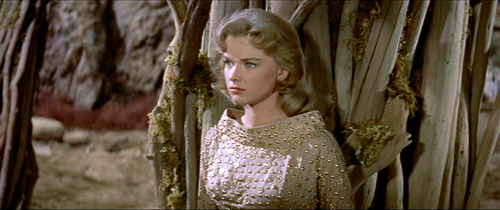
Realizing that Adams and his men don’t plan to leave anytime soon (do you blame them?), Morbius gradually reveals his story: The expedition discovered the relics of an extinct alien race called the Krell; he translated their language, and used a Krell device to enhance his intellect. Of the original Belerophon crew, only he and his wife wanted to remain on the alien planet; when the others tried to leave, a mysterious living force killed them all.
Now, some twenty years later, that invisible monster has returned. And once again it is bedeviling those who would separate Morbius from his beloved Krell studies. It doesn’t care for guys who put the moves on Morbius’ daughter either. In fact, the only person who seems safe from it is… Morbius. Hmm.
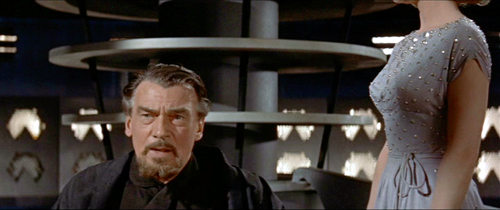
Portrait of a Man With a Lot on His Mind
The Lowdown
Welcome to Forbidden Planet. There are better ‘50s sci-fi movies, but none that so perfectly embody the idea of what a ‘50s sci-fi movie ought to be. Got your flying saucer, right here. Got your robot, ray guns, an underground city, a deadly monster, a mysterious scientist with a laboratory, and a sexy girl; all in full color and widescreen. Bonus: an ingenious central concept and a fairly literate script.
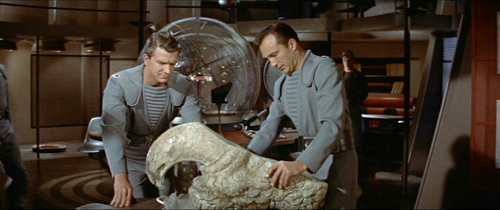
"It burns when I pee."
The film is most commonly noted today for its classical references: the storyline and characters correlate strongly with William Shakespeare’s The Tempest, and the Shakes-in-Space concept is only one of the details Gene Roddenberry would borrow for Star Trek ten years on. What attracted MGM to the project was its psychological angle. The invisible creature, we discover, is no alien being but Morbius’ own mind: his sublimated primal impulses made manifest by his connection to the Krell Machine. Interestingly, the screenplay quickly dismisses as archaic a character’s Freudian reference to an “Id Monster”, but the name sticks. It’s certainly catchier than “Jungian Shadow Figure”.
Science fiction has always been preoccupied with the fear that humanity could be one day displaced by its own technology. In the ‘50s, that school of thought received an atomic-powered boost: suddenly, we really did possess the power to destroy ourselves—and, insanely, dared ourselves to use it. Forbidden Planet never speaks of nuclear holocaust, and its monster is no fallout-derived mutation, but the lesson of the Krell would have been quite clear to a post-WWII audience.

"You think that’s big, wait ’til you see the skeeters."
Around that same time, the great sci-fi writer Isaac Asimov was proposing at least one solution for keeping ahead of technology: hobble it. His Three Laws of Robotics mandate parameters for artificial intelligence; Robby is one of the best cinematic expressions of that concept at work, and we see its advantages and limitations.
Here’s my deal with Robby, though. All the reviewers I’ve read equate him with Ariel, Prospero’s spritely familiar in The Tempest. And sure, he’s well spoken, sympathetic, and possesses uncommon powers. But think about it: There’s nothing ethereal about Robby. He’s completely earthbound, programmed by Morbius and held to Morbius’ rules. He’s the one who does the heavy lifting. He’s the one who takes out the trash. He sees the girl naked but is denied sexuality. Also (and this should be the giveaway), he’s the one who goes off drinking with the ship’s most clownish crewmember. He’s Caliban.

"-Hi-there–sailor-…"
A hidden aspect of The Tempest is that both of Prospero’s mystical helpmates resent his dominion. Caliban may plot openly against him, but Ariel, outwardly loyal, serves only for the promise of eventual freedom. This interpretation tracks for the Id Monster: a creature of air and fire that carries out its master’s whims but is ultimately unknowable.
I’m spending time on this point because once one stops thinking of Robby as innately ‘friendly’ one can see how ‘he’ is just another laborsaving device and this, perhaps unintentionally, bolsters the movie’s main theme of human self-obsolescence. Were Forbidden Planet’s writers consciously making statements about the inequities and false comforts of their time? For that matter, was Shakespeare? According to Frederick S. Clarke and Steve Rubin’s landmark 1979 article in Cinefantastique (to which I am greatly indebted), scenes like Altaira’s swim in her Edenic playground, with its additional echoes of the Artemis myth, were added to satisfy a need for eye candy, not thematic complexity. And I suspect that if old Billy hadn’t concocted a drunk scene for his Low Characters the Globe’s audience would have demanded one.
And Forbidden Planet is an audience pleaser, balancing its highbrow aspirations with inventive visuals. Robby alone is a triumph of design and engineering, and the animation effects (wisely contracted to the Disney Studio) contribute to one of the most indelible sci-fi images ever: the invisible Monster, outlined in the rays of a disintegration field.
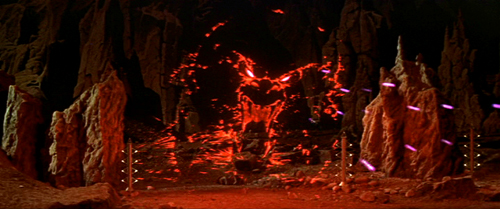
The Package
Disc A:
The anamorphic transfer is presented at 2.40:1, somewhat short of the film’s early-Cinemascope ratio of 2.55:1. It’s sharp and clear, but hasn’t received the top-flight restoration one might expect from Warners: dirt and scratches (and, yes, wires) are occasionally visible.
Audio is remastered 5.1. I usually object to old movies receiving new mixes without some preservation of the original sound. In this case we appear to have a faithful recreation of the film’s stereo mix, with dialogue following actors around the soundscape instead of residing on the center channel as is standard today. David and Bebe Barron’s unique pre-synthesizer electronic score is gorgeously eerie.
The deleted scenes are interesting but of very low technical quality—the story goes (again, thank you, vintage Cinefantastique) that the only reason a 16mm workprint survived at all was because the Barrons used one for reference while recording their score in New York and never returned it to MGM. What we have here is a glitchy videotape transfer from that print. Most of the omissions are extraneous bits of dialogue cut for pacing reasons. One scene, deleted due to poor execution, I would have liked to retain: Robby describes his functions as ‘positronic‘ in nature, confirming his Asimovian heritage.
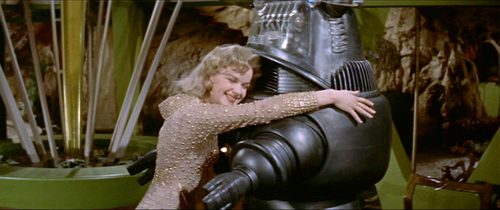
"-Are-you-sure–you’ve-never-seen–a-man-before?-"
The ‘lost footage’ is a collection of special-effects tests, and looks a lot better, being a direct transfer from 35mm film elements. Unfortunately, the presentation here has been panned-and-scanned from the ‘scope originals. Both galleries include text explaining the context of the shots. I wish more supplement packages did this.
Disc B:
For 49 years, The Invisible Boy has survived as little more than a footnote to Forbidden Planet, thanks to Robby the Robot’s reappearance. It’s fitting, then, that it makes its DVD debut on this set. And for what it’s worth, this is what most ‘50s sci-fi movies really looked like:
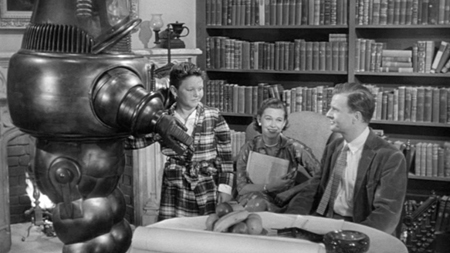
The two new documentaries are fairly informative, but noisy and hyper in the current fashion. Both could stand to go into twice as much detail as they do—especially since there’s no commentary track on the main feature. A montage documenting the many re-uses of the production’s costumes and props in other films and TV shows would have been nice to have here. Watch the Skies!, on the other hand, is a thoughtful hour-long overview of the ‘50s sci-fi boom, and contains interviews with some very big names.
This is a fine release (finer still if you get the Ultimate Collector’s Edition), but Warners will likely want to make another pass before putting together an HD version.
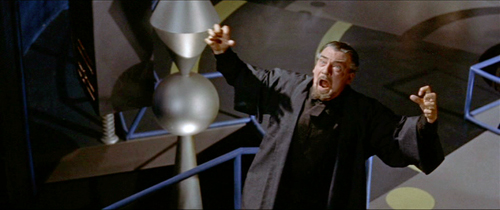
"This can’t be happening! Kevin Bacon hasn’t even been born yeggghhh"